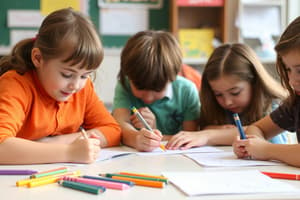Podcast
Questions and Answers
What is a recommended practice to ensure students' safety when using scissors in art class?
What is a recommended practice to ensure students' safety when using scissors in art class?
- Allow students to use scissors freely to encourage creativity
- Instruct students to keep scissors in their desks at all times
- Provide children with sharp scissors for precision cutting
- Demonstrate proper usage and store scissors out of reach (correct)
Which factor should be least considered when selecting materials for an art activity?
Which factor should be least considered when selecting materials for an art activity?
- The students' financial capacity to purchase materials
- The availability of the resources in the local area
- The possibility of improvisation with alternatives
- The preference of the instructor's favorite media (correct)
What type of materials should be avoided to ensure safety in art classes?
What type of materials should be avoided to ensure safety in art classes?
- Non-toxic paint for easy cleanup
- Small items that pose choking hazards (correct)
- Washable markers for clean hands
- Scissors designed for children's use
What is the appropriate action to take to maintain art brushes used with acrylic paint?
What is the appropriate action to take to maintain art brushes used with acrylic paint?
When planning an art lesson, what is crucial regarding resource availability?
When planning an art lesson, what is crucial regarding resource availability?
Which safety precaution should be emphasized when teaching art to young children?
Which safety precaution should be emphasized when teaching art to young children?
What should be done to prevent allergic reactions during art activities?
What should be done to prevent allergic reactions during art activities?
What is the importance of teaching proper care for art materials?
What is the importance of teaching proper care for art materials?
What is the most effective way to reuse leftover paint on a palette?
What is the most effective way to reuse leftover paint on a palette?
Why is proper workspace management crucial in an art class?
Why is proper workspace management crucial in an art class?
Which factor is least relevant when planning an art lesson?
Which factor is least relevant when planning an art lesson?
In terms of time management for art classes, what is a common struggle for teachers?
In terms of time management for art classes, what is a common struggle for teachers?
What is a primary concern for teachers who do not have a dedicated classroom?
What is a primary concern for teachers who do not have a dedicated classroom?
When using paint in a classroom, which of the following should not be a major concern?
When using paint in a classroom, which of the following should not be a major concern?
What should be done if the tables used in an art class are likely to get painted?
What should be done if the tables used in an art class are likely to get painted?
What is an ideal session length for preschool art classes according to the discussed content?
What is an ideal session length for preschool art classes according to the discussed content?
Flashcards are hidden until you start studying
Study Notes
Ensuring Student Safety
- Prioritize student safety during art classes as young children can get excited or frustrated.
- Keep sharp objects like scissors out of reach of younger students.
- Emphasize proper usage and storage of materials; teach how to handle scissors safely.
- Use non-toxic materials to prevent health risks in case of ingestion.
- Be mindful of choking hazards, such as small beads and pompoms.
- Watch out for allergic reactions from skin contact or inhalation of art supplies.
- Address potential slip hazards from spilled water containers.
Selecting Appropriate Materials
- Assess the availability of art resources when planning activities to ensure effectiveness.
- Plan lessons based on accessible materials; avoid scenarios where key supplies are missing.
- Evaluate whether materials need to be provided by the teacher or if students can supply their own.
- Consider substituting materials and explore alternatives if certain resources are unavailable.
- Determine if materials should be used individually or shared among students.
Caring for Art Supplies
- Teach proper care and maintenance of art materials to prolong their lifespan and usability.
- Clean paintbrushes immediately after use, especially when using acrylics, to prevent damage.
- Use buckets of water as a makeshift cleaning solution if a sink isn't available.
- Avoid prolonged soaking of brushes in water, as it can lead to permanent damage.
- Regularly clean palettes, and for leftover paint, cover with a hard plastic lid to keep it usable.
Maximizing Workspace and Resources
- Consider workspace management, venue layout, and water supply during lesson planning to prevent chaos.
- Choose appropriate surfaces for activities, making sure to protect tables and floors from paint spills.
- Ensure water sources are available for clean-up and art-making processes.
- Check for adequate lighting and ventilation in the workspace, especially when using spray paint or oil.
- Plan for proper waste disposal to manage messy materials and prevent plumbing issues.
Effective Time Management
- Develop a structured routine to efficiently manage class time, especially in short sessions.
- Recognize that preschool art classes average 30 minutes and elementary classes about 45 minutes.
- Prepare to set up the workspace quickly, involving students to enhance collaboration.
- Allocate 5-10 minutes for clean-up at the end of art classes to ensure a smooth transition to other activities.
- Being an Art-in-the-cart teacher necessitates heightened organization due to changing environments.
Studying That Suits You
Use AI to generate personalized quizzes and flashcards to suit your learning preferences.




